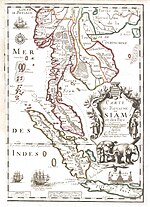Kingdom of Singhanavati | |||||||||
|---|---|---|---|---|---|---|---|---|---|
| 691 BCE–638 CE | |||||||||
| Capital | Yonok Nahaphan (691 BCE–545 CE) Wieng–Prueksha (545–638) | ||||||||
| Common languages | Old Thai | ||||||||
| Religion | Theravada Buddhism Mahayana Buddhism | ||||||||
| Government | Chiefdom | ||||||||
| Historical era | Middle Ages | ||||||||
• Formation | 691 BCE | ||||||||
• Fall of Yonok | 545 CE | ||||||||
• Formation of Ngoenyang | 638 CE | ||||||||
• Disestablished | 638 CE | ||||||||
| |||||||||
| History of Thailand |
|---|
 |
|
|
Singhanavati (Thai: สิงหนวัติ; RTGS: Singhanawat) was a Tai semi-legendary kingdom based along the Kok River in the Chiang Rai Basin in northern Thailand,[1] existed from 691 BCE to 638 CE.[1]: 7 It was centered in Yonok Nahaphan (Chiang Saen District, Chiang Rai) and then moved to Wieng–Prueksha (Fang District) after the old capital was submerged below Chiang Saen Lake due to an earthquake in 545.[2][3][4]
Singhanavati evolved into the Ngoenyang Kingdom in 638, which continued to the formation of Lan Na in 1292.
- ^ a b "Wiang Nong Lom Cultural Heritage" (PDF). Fine Arts Department of Thailand. 2023. Archived from the original (PDF) on 21 January 2024. Retrieved 21 January 2024.
- ^ "เมืองโยนก นครในตำนานล้านนา" (in Thai). Fine Arts Department of Thailand. 2022. Archived from the original on 18 January 2024. Retrieved 18 January 2024.
- ^ ""รอยเลื่อนแม่จัน" กับ "โยนกเชียงแสน" ตำนานที่อาจมีอายุมากกว่า 1,800 ปี" (in Thai). Manager Daily. 24 April 2020. Archived from the original on 18 January 2024.
- ^ Wood, Spencer H.; Wood, Layle R.; Ziegler, Alan D. (2 November 2015). "Natural degradation of earthworks, trenches, walls and moats, Northern Thailand". Journal of Field Archaeology. 40 (6): 675–694. doi:10.1080/00934690.2015.1103645. ISSN 0093-4690. S2CID 32414373.
© MMXXIII Rich X Search. We shall prevail. All rights reserved. Rich X Search
